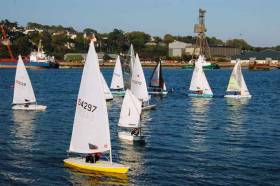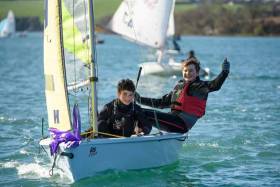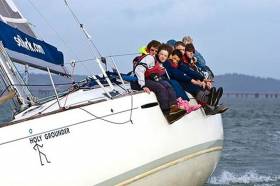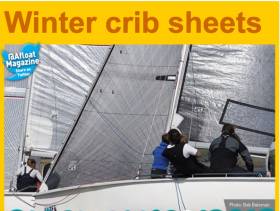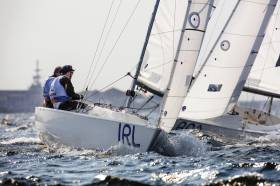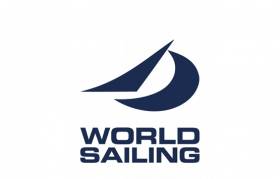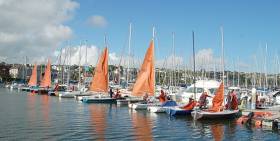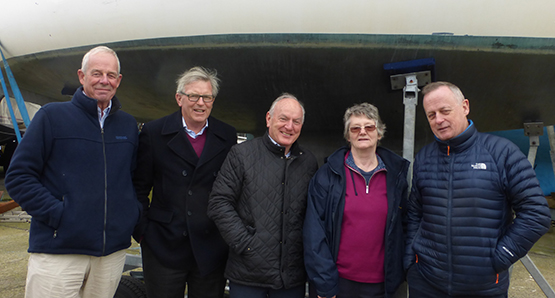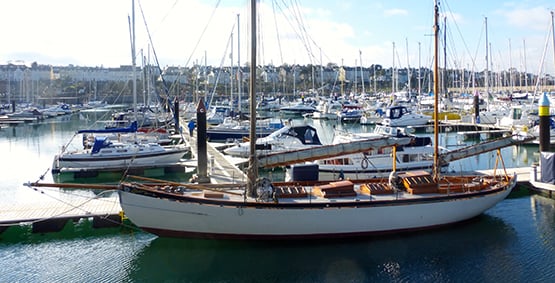Displaying items by tag: sailing
Sailing Season Underway in Cork Harbour
The sailing season is taking off in Cork Harbour, with good weather this week writes Tom MacSweeney. Cove Sailing Club will announce its racing programme at a pre-season launch on Friday, which will include a joint programme for whitesail cruiser events with neighbouring Monkstown Bay.
Weekly cruiser racing begins tomorrow night at the RCYC and the first of the whitesail evening league races is scheduled for Friday. Dinghy racing is on Wednesdays and at weekends.
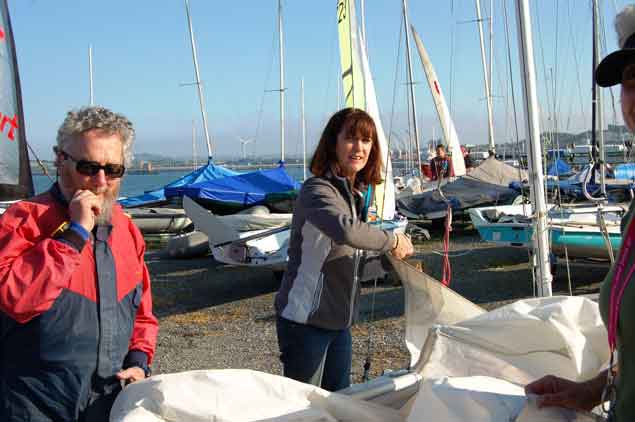 John and Judy Moynihan - stalwart dinghy sailors at MBSC prepare for the first night's racing
John and Judy Moynihan - stalwart dinghy sailors at MBSC prepare for the first night's racing
Monkstown Bay Sailing Club had eleven boats on the water, racing in two classes for the opening night last night. A steady south-easterly, flat water and sunshine made a good start to the season in the harbour.
How Can Irish Sailing Keep The ‘F In Fun’?
Could British sailing’s own difficulties with maintaining the ‘fun factor’ to attract more racers and fans have repercussions for the ISA’s recent efforts to rejuvenate the sport in Ireland?
David Henshall writes for Yachts and Yachting about measures that can be taken to ensure the ‘f in fun’ isn’t lost from the British sailing scene.
And his conclusions would surely be just as pertinent on this side of the Irish Sea.
One issue identified is time, or the use of it. The article cites Finn Olympic medallist Luca Devoti as one helm at the pinnacle of the sport who sees that as more racing is compressed into the available time, “the more it favours the elite sailors that increasingly are dominating our sport”.
Indeed, it’s not difficult to see why amateurs might be dissuaded from prepping their boats for any weekend meet where the fleet will be ruled by more aspirational professional or semi-pro sailors on the elite track, for whom the results are all.
What can British clubs do to make inroads? Henshall suggests more midweek and after-work sailing meets — something Irish sailing clubs are already making efforts to do this summer season.
But it’s not just about scheduling, it’s also about creating the conditions for more fun on the water. That means considering what the majority of participants want from their races, not what the principal of peak competition demands.
Sailing weeks — combining on-the-water races on unorthodox courses, eschewing the standard windward/leeward runs, with a shoreline festival atmosphere — are cited as one way to buck the trend and maintain a sense of fun.
Open meets in the junior classes like Oppys and Toppers remain successful in the UK and Ireland alike, and fresh thinking at governing-body level is encouraging a new greater sense of ensuring the fun is in taking part, not just winning and striving climb the ladder of success.
What’s more, classes like the lighting-quick Moth, while bringing a new sense of excitement to sailing for competitor and spectator alike, are also fuelling a revival of their non-foiling classic brothers
The shake-up of the ISA-up of the ISA in recent years has seen a push for one-design classes, where the potential for fun is greater than in handicaps — after all, everyone sailing the same boat levels the playing field and reduces that sense of frustration lower-level sailors must feel when higher performance vessels leave them in their wake.
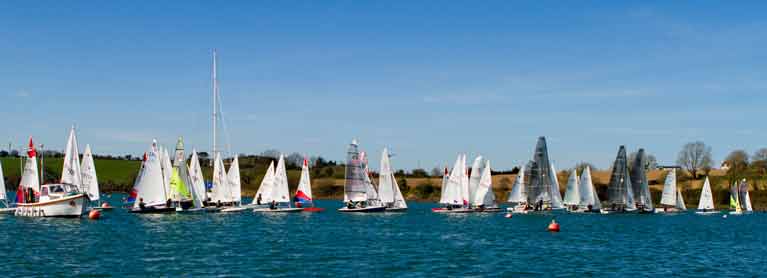 Mixed dinghies compete at Royal CorkYacht Club's PY 1000 event in Crosshaven Photo: Bob Bateman
Mixed dinghies compete at Royal CorkYacht Club's PY 1000 event in Crosshaven Photo: Bob Bateman
Things aren’t helped by a proliferation of new designs driven by the high-performance level, writes Henshall, which are “fragmenting the scene” and ultimately mean little to grassroots club sailors — the equivalent of trying to sell sports cars to commuters.
Can there be a balance between fun and performance? Henshall suggests the D-Zero design in Britain as a prime example, where neither is sacrificed for the other. The question is, is there a similar mid-range dinghy class that offers the same in Ireland?
What else can be done in the Irish sailing scene to ensure the ‘f in fun’ isn’t lost? Have your say in the comments below!
Irish Sailing Is Responding To Changing Circumstances
After decades of expansion, many participant sports which are at the heart of our way of life have in recent years seen the numbers actively involved becoming static at best, and in many cases contracting. This is particularly the case with non-spectator sports, and sailing is very far from being immune to the trend. W M Nixon takes a look at a developing situation, and how it might develop in the future.
The acute economic recession of 2007-2009 certainly had a damaging effect on amateur recreation generally, and particularly on costly vehicle and equipment sports, of which sailing is a prime and high profile example. But as well, the way that people live now, with increased consumer choices in sport as in other areas of recreation, means that the traditional Irish club sailing model, with its attendant clubhouse and facility costs, has to undergo change if it is to achieve some new level of dynamic equilibrium to function successfully in the future, and attract new membership.
The recent sad death of Arthur Rumball, who had played a significant role in the expansion of the Irish National Sailing School in Dun Laoghaire, inevitably poses the question of why the INSS could report such impressive numbers of newcomers giving sailing a try, with many of them going on to more active involvement, yet it is no secret that sailing clubs sharing Dun Laoghaire Harbour were in some cases seeing alarming fall-offs in activity and membership.
With the inspiring leadership of its founder Alistair Rumball, the INSS had come through the recession by quickly adjusting to the deteriorating situation, severely reducing its costs, and utilizing other sources of income to maintain the momentum to put it in a strong position to revive after the recession. Now it has a more active and larger training fleet than ever, it has put thousands of people through its courses, and in 2015 it even founded its own sailing club within its own structure in order to enable its alumni to enter major events without the significant personal cost incurred in being members of one of the historic yet inevitably expensive Dun Laoghaire yachts clubs

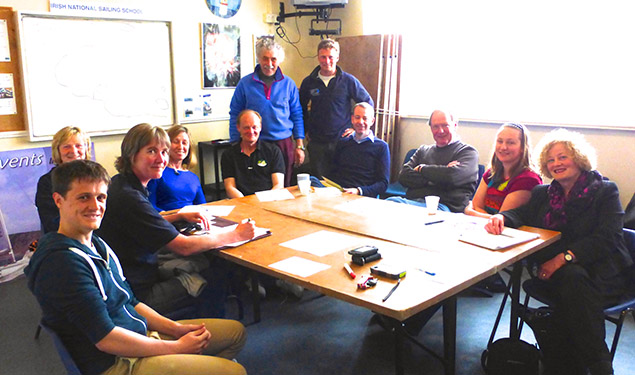
With a commercial marina at its heart, the Dun Laoghaire sailing establishment faces the challenge of people being involved in sailing on Dublin Bay without being involved in the traditional membership of the waterfront clubs. It was an issue which was addressed here on November 22nd with a discussion inaugurated in a thoughtful article by David O’Brien which highlighted the problems facing the existing Dun Laoghaire sailing setup.
In such a situation, there’s a tendency to think that local solutions must be found to what is perceived as a local problem, but in fact it’s a worldwide matter. The reality is that in Europe, boat numbers and major sailing events are tending to shift southwards towards sunnier climes and warmer seas, and the northern countries such as Ireland, the UK, the Netherlands and Scandinavia, the places where recreational sailing has a much longer history, are seeing a sometimes small but always significant decline.
Thus in The Netherlands – which I would tend to view as Europe’s premier maritime nation – the national sailing authority is anticipating a fall-off in boat numbers of 25% by 2050. But whether that means a fall-off of 25% in participating sailors is another matter altogether, as the reckoning is that boat-sharing is going to rise, and inevitably with it the professional management of group-owned boats.
This may well be the biggest longterm problem facing Irish yacht and sailing clubs. In the final analysis, the private yacht owner is the backbone of any club, for an owner who wishes to get the best possible value from his boat will usually see his club as an important adjunct of the total package, a backup service to provide facilities for the socialising of his crew. This is particularly so in the case of top racing boats, which will need a crew panel of perhaps as much as three multiples of the actual racing crew in order to ensure that a full racing crew is always available.
That said, I do realize that there are owners who keep their boats in Dun Laoghaire marina and yet are able to get an active racing programme thanks only to their membership of Dublin Bay Sailing Club. And equally I realise that there are cruising enthusiasts who operate out of Dun Laoghaire marina without being a member of any club at all. That is their right and privilege, but for the rest of us, membership of a club with its unique history, traditions of voluntary service, shared enthusiasms, and pooling of resources is an integral part of the entire sailing experience.
But as the already old clubs become even older with every passing year, how do they continue to appeal to newcomers who see sailing as just another experience in life’s rich tableau? Something to be tried for one weekend perhaps? But the next weekend, you might try something entirely different? And who knows what you might be tasting the weekend after that?
Surprise us, just surprise us - that’s what they demand. For a significant sector of the population, modern leisure life is a sort of tasting menu of recreational experiences. If we acknowledge that this is the case, then we should be happy that the growing number of sailing schools can cater for newcomers whose longterm involvement in sailing may range from just one weekend around boats per year, to the almost obsessional involvement and enthusiastic participation in every possible moment by the people who give their hearts and soul to serving the sailing clubs to which in the end they give their total loyalty.
 Normally we associate the INSS’s Reflex 38 Lynx with high-profile racing, but for much of the time she has to earn her keep introducing newcomers to cruiser sailing, as seen here on passage through Dalkey Sound.
Normally we associate the INSS’s Reflex 38 Lynx with high-profile racing, but for much of the time she has to earn her keep introducing newcomers to cruiser sailing, as seen here on passage through Dalkey Sound.
The problem for clubs in trying to accommodate such a range of involvement is that if they distort their true character too much in order to attract casual newcomers, they will offend their established membership. But if the old guard totally rule the roost, newcomer will be immediately put off. Underneath it all is the ever-present problem of money, for we may have had as much as an entire lost decade of static or reduced income.
Even though the national economy itself is improving, that economy is in the here and now. At a personal level, there are lasting legacy issues for people who were particularly hard hit during the recessionary years, and whose personal finances may never fully recover. Club managements have to accommodate such people who have given much in time and energy, and have much still to give, to the club which they see as central to their sailing.
But those who would adopt a more brutalist approach will suggest that the most ruthless market forces be allowed to operate, and if for instance a club’s catering can no longer match the hospitality package of nearby restaurants and pubs with food, then it should either put its entire restaurant out to contract and public use, or else diminish the service and acknowledge the fact that people go elsewhere.
As to direct waterfront facilities for servicing boats, the brutalists would sometimes suggest that they too should look to professional sourcing rather than expect them to be organised on an ad hoc basis by the clubs, as is largely the case in the Dublin area. Yet the fact is it works – if it ain’t broke, then why try and fix it?
The irony of all this is that the leading providers of professional sailing introduction and instruction through the sailing schools of Dublin and Cork Harbour are themselves products of established yacht clubs. The late Arthur Rumball as a kid used to spend almost every waking hour in and around Malahide Sailing Club “messing about in boats”, such that - as a former officer of the club put it this week - no matter who you were, if you really wanted to know what was going on about the place, Arthur was the most reliable source of all information. And in adult life, he was married to the daughter of a former Commodore of one of the premier Dun Laoghaire yacht clubs.
As for his older brother Alistair, seen by many as Irish sailing’s ultimate maverick and cage-rattler, the fact is that for many years he has been a member in good standing of another of the historic waterfront clubs. It’s a place of which he is so fond that he has said of it with pride that you either get it, or you don’t, and if you don’t get it – that is, comprehend its deeper meaning almost immediately through some sixth sense - then there’s no point in anyone trying to explain to you what it’s all about.
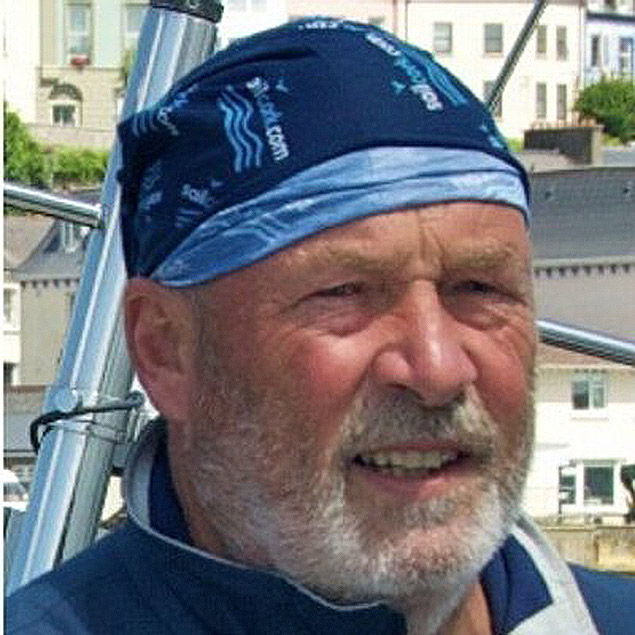 Eddie English of SailCork
Eddie English of SailCork
Equally in Cork, the great Eddie English of SailCork is a pillar of one of Cork Harbour’s leading sailing families. Yet he, like the Rumballs, became impatient with the yachting establishment’s reluctance to welcome total newcomers to the sport with complete enthusiasm, and so since 1974 he has been running an expanding operation which has introduced many to sailing.
Some of them enjoy the experience of sailing with Eddie English so much that they return year after year to make the learning of sailing their hobby, but others go on to themselves become central to the club-based Cork Harbour sailing scene. As for Eddie’s mission in life, it has long included an international dimension, as charter cruises with SailCork crews in the Caribbean have become a staple of the annual programme. But so too is active co-operation with local clubs – in the New Year, SailCork will be running a course within the Royal Cork YC membership in Crosshaven.
One of the factors in the current difficult situation is that sailing has become newly high profile thanks to Annalise Murphy’s Silver Medal in the Rio Olympics, and the generally high standard of results being achieved both by the rest of the Olympic sailing team, and the top sailors in the ISA’s High Performance squad.
 It lifted everyone’s spirits – junior sailors at the National Yacht Club in Dun Laoghaire celebrate their clubmate Annalise Murphy’s Silver Medal in Rio, August 2016. Photo: Michael Chester
It lifted everyone’s spirits – junior sailors at the National Yacht Club in Dun Laoghaire celebrate their clubmate Annalise Murphy’s Silver Medal in Rio, August 2016. Photo: Michael Chester
This may be fine and dandy for those who wish sailing to be seen in a good light by the general public, with all that might mean in improved government grants. But it meant that at grass roots level, your everyday sailor of average achievement has felt distinctly left out, and that in turn was leading to a fall-off of interest in ordinary club activity.
But there are encouraging signs that a realization of the unhealthy nature of a sailing scene overly skewed towards excessive interest in superstars is leading to a reaction in favour of looking after the needs of ordinary sailors. A significant sector of our sport would like to see less of the spotlight totally focused on racing, and club managements are taking notice of this.
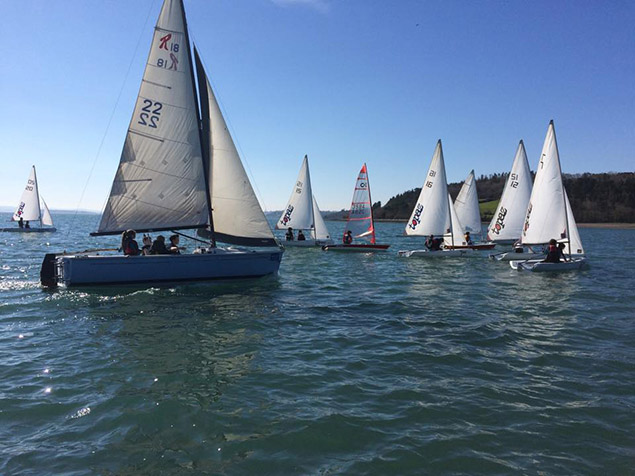 “Just get them afloat and sailing, and the interest and involvement will take off from there”. SailCork’s motley fleet does sterling service on Cork Harbour.
“Just get them afloat and sailing, and the interest and involvement will take off from there”. SailCork’s motley fleet does sterling service on Cork Harbour.
 Graduate level. SailCork’s First 36.7 Holy Grounder regularly cruises to West Cork and beyond.
Graduate level. SailCork’s First 36.7 Holy Grounder regularly cruises to West Cork and beyond.
One of the questions raised in the discussion on the 22nd November think-piece was brought up by cruising guru Norman Kean, who noted that just about everything being discussed related to racing matters, whereas those who really do prefer simply messing about in boats may well be the majority.
But racing produces its own flow of publicity with a narrative simply by publishing results, whereas for many, proper cruising is a blind spot except where log competitions have been introduced. Yet the cruisers are there. One of the interesting points to emerge from this week’s AGM of Howth YC was the news that HYC’s Cruising Group, founded with the opening of the new clubhouse in 1987 at the instigation of Commodore Tom Fitzpatrick with Gary McGuire as the first convenor, is now a gathering of like-minded souls who number around 120, and they meet regularly and frequently to share and develop their non-competitive interest in boats and sailing.
This is an important part of what a healthy yacht club’s life - week in, week out - should be all about. But providing it at an affordable cost is a matter of sound management and the readiness of the membership to come forward to fill essential voluntary roles. The yacht and sailing clubs of Ireland have been through a torrid time in recent years. But the signs are that an increasing number of people are now realizing that in the constant flux of modern life, the clubs are an important anchor in our maritime life.
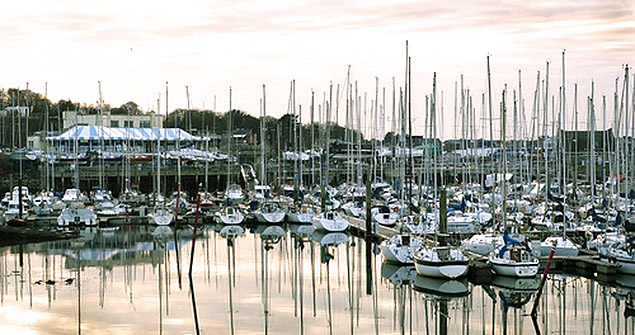 Howth YC and its marina - the clubs are an important anchor in our maritime life. The HYC Cruising Group has 120 members who meet regularly and frequently, and racing is most definitely not on their agenda.
Howth YC and its marina - the clubs are an important anchor in our maritime life. The HYC Cruising Group has 120 members who meet regularly and frequently, and racing is most definitely not on their agenda.
Thus it’s the duty of every member to contribute to this improved mood. Your club should not be seen as some commercial service to be criticized as a matter of course, Rather, you should see your club as something of which you are part, and to which you should contribute in a positive way, and to which you should welcome newcomers. Ultimately, you’ll only get out of sailing and club life what you put into it in the first place.
Dun Laoghaire Yacht Clubs Must Put On a United Front
Combining efforts and pooling resources are key to securing the future of yacht racing from Dun Laoghaire’s legacy waterfront clubs, writes David O’Brien
Welcome to Dun Laoghaire, the cradle of world yacht racing. It's here that the modern rules for the sport were written in the 1870s. And today, the location still boasts the top sailing waters of any capital city, plus the finest Georgian yacht clubs anywhere in the sailing world, with not one but three world class clubhouses in a row on the waterfront — namely the Royal St George, now in its 178th year; the National Yacht Club, which celebrates its 150th anniversary in 2020; and the Royal Irish, the eldest of the three at 185. Celebrating over fifty years on the West Pier is the more recent Dun Laoghaire Motor Yacht Club.
Though they developed individually, this year and last these clubs have had a joined purpose, focused on saving sailing from the perceived threat of a giant cruise liner berth in Dun Laoghaire Harbour.
But ironically, the real threat to the sport lies elsewhere. A decline in sailing numbers and a change in sporting trends are putting a strain on these ancient yacht clubs, leaving them shorn of membership, marooned in their own harbour.
These clubs have at their heart a dedicated and hard-working membership who are passionate about sailing. It is far removed from the recent view in the Sunday Independent, quoting an unnamed source to describe their different ethoses in unflattering terms: “The one nearest the city, the Royal Irish Yacht Club, is for protestants, the one furthest, the National Yacht Club, is for Catholics, and the one in the middle, the Royal St George, is for Catholics who think they're protestants.”
Anyone involved in sailing will tell you that’s rubbish from a bygone era. Unfortunately, it hints at what those outside the sport might still think of it.
Added to this, recession and austerity have been tougher on equipment sports such as sailing, where the running costs are relatively high. It's not only an Irish problem, but it has caused great cracks in Dun Laoghaire's historic sailing lines.
Their stuffy Victorian image, too, hasn't helped to recruit new members, as participation continues to drop. The number of sailors that remain in Dun Laoghaire may total up to 5,000 but not all are yacht club members, and many are getting on in years.
Insiders says there’s a window here for about five years while the domestic sailing classes still have a good turnout. After that, it’s feared the whole scene could disappear — not helped by a lack of cash among thirty–to–fifty–somethings.
It’s a problem throughout Northern Europe. The Dutch, for example, foresee a 25% reduction in their national fleet by 2050.
Unique propositions
Dun Laoghaire clubs have traditionally enjoyed two unique selling propositions for well over 100 years, but both have disappeared over the last two decades.
Firstly, the clubs once enjoyed an unmatched reputation for first-class, exclusive dining, but this has been eroded to such an extent by the emergence of quality high-street restaurants that some clubhouses no longer offer a daily service. The clubs have lost their social cachet.
Secondly, the clubs once controlled access to the water through harbour moorings and the slipway. However, since the opening of the country’s largest public marina in 2001, boat owners no longer need to be yacht club members to go boating.
It's not all doom and gloom; there are parts of sailing in rude health, especially in Olympic-style youth competition. Yet crucially, this has not transferred to senior fleets who are more inclined to take out yacht club memberships at approximately €1,500 per annum.
If we don't respect our past then we'll find it harder to build our future. Dun Laoghaire's institutions have survived many crises including two world wars and countless recessions. It's proof of the enduring love of sailing in the capital's waters.
An Irish Sailing Association (ISA) task force has been charged with finding a way to link its high performance sailing initiatives to domestic classes. In 2006, the ISA had 22,000 members; 10 years on and numbers are back down to 1996 figures at around 17,500.
 Fun Racing in DBSC's Winter Turkey Shoot series and offshore racing with ISORA has flourished in recent years
Fun Racing in DBSC's Winter Turkey Shoot series and offshore racing with ISORA has flourished in recent years
A new model for the sport – SAILING is the real USP
Ironically, the club that first coined the yacht racing rules, the clubhouse-less Royal Alfred Yacht Club (RAYC), was wound up last year and incorporated into the much larger Dublin Bay Sailing Club (DBSC). The move is symbolic because it presages a much bigger need to rationalise other aspects of the sport in the harbour.
Dun Laoghaire – or Kingstown as it was in the Victorian era – is where the racing rules were first drawn up and the modern sport of yacht racing was born. If a new regeneration plan can be hashed out, it may well become the place where a new model for the sport is born, too.
Critical to the solution is to bring SAILING to the forefront, make the sport more accessible and reduce the cost of taking part.
In the good times, everyone helped themselves to a slice of the yachtsman pie to the extent that between various membership and berthing fees, it still costs upwards of €10,000 per annum to campaign one of the harbour's standard keelboats, equivalent in some cases to the purchase price of the boat.
Sailors themselves have already worked out ways to circumvent the rules to keep their own costs down. Anecdotally, we know some have ditched the boat altogether and are crewing on other boats. Others are competing only at events and not participating in club sailing, the heart of the sport. Often sailors are going directly from the marina without joining a club at all. In some cases, one sailor from a crew of 10 is nominated to join a club, just to comply with racing rules.
In order to maintain these trappings of yesteryear, while unable to generate it from a dwindling sailing membership, the club administrations have gone after other revenue streams. Currently weddings and corporate events are the order of the day.
In many ways, this redirection compounds the problem for the sport, because in order to compete for such business against more established operators in the hospitality sector, the clubs have to gear up on staff and senior management to run these events successfully. Currently the waterfront wage roll is approaching €3 million per annum. The question is, how much of this money is going to run sailing, and how much to run weddings? Is it the case that neither are being served well?
This is not the fault of current committees, who are merely custodians of these protected structures and are charged with the not insignificant upkeep of these historic buildings but if you do what you always do you will get what you always get.
So how can we keep what we have and bring 'Sailing' to the forefront?
Surely rather than to look inward we should look for a solution that can grow the sport to benefit everyone and chart a future for not just the clubs but all the stakeholders in Dun Laoghaire and the Sport. This is not to throw out what we have but to develop that new extra dimension to Dun Laoghaire sailing that is missing. It is to recognise that life is different for the younger generations and unless we change tack we are making it very difficult for interested sailors to enjoy the sport through club membership.
Other marine sports like SUP, kayaking, kite surfing are growing immensely in popularity. They don’t require a club, a boat and a bar tab or a marina berth so there is competition coming from all sides.
Surely there could be a collective solution to fix the problem of making sailing less expensive? Hard choices need to be made, not only to save the clubs per se but the sport itself.
A collaboration of the stakeholders would rationalise costs and could bring–in a much larger public element that would sustain the sailing scene. With Dublin city on the doorstep surely there is a market to provide the capital's population with simple sailing and shore facilities? If the clubs could tweak the existing offering, the scene could be much more embracing.
And there are examples where 'tweaks' have already borne fruit. New initiatives for offshore sailing under ISORA and winter racing via DBSC's impressive Turkey Shoot are positive signs that sailors respond well to new ideas when they combine leadership, fun racing and shoreside craic. And every two years the clubs combine to produce Ireland's largest regatta at Dun Laoghaire a fleet that has, at times, topped 500 boats.
 Every two years since 2005 Dun Laoghaire's waterfront clubs combine to produce Ireland's biggest sailing regatta that attracts as many as 500 boats
Every two years since 2005 Dun Laoghaire's waterfront clubs combine to produce Ireland's biggest sailing regatta that attracts as many as 500 boats
Addressing the core issues
If Dun Laoghaire’s clubs can get the sailing right, everything else can flow from there. This is a big question but a good start would be to focus the combined efforts of the stakeholders to address how they adapt to the changed environment. Because if they don’t, everyone will suffer in the long term. A start would be to recognise that:
- Combined membership of the waterfront clubs has been static over past two years and is still 30% below 2006 levels.
- Racing fleets are declining and high costs are fuelling a move to access the water from outside the club networks.
- The clubs are all running active junior programmes, but have poor conversion to membership.
- The clubs are struggling to keep the young adult group (ages 25–40) actively involved.
- The clubs are failing to attract significant newcomers or ‘try sailors’ into club membership.
- Clubs need to direct more resources to support existing sailing members and to attracting new sailors.
Right ingredients
As a centre of sailing, not just for Ireland but for Europe, and even the world, Dun Laoghaire has all the right ingredients to be successful.
A population of over one million is right at its doorstep, while the town itself boasts a large and firmly established club network and race organisation, a sizeable public sailing school with excellent facilities and easy access to the sailing area, plus a supportive county council and harbour authority.
So why are Dun Laoghaire’s clubs still struggling? One problem is that they are too focused on senior membership and trying to use the ‘old model’ to address this new environment.
Time (or the lack of it) and costs (higher than they ought to be) are key deterrents for the young adult group. Participation requires a disproportionate financial commitment, and organised racing as it stands often doesn’t fit with family and work commitments.
Maintaining club facilities, meanwhile, requires an ever larger proportion of available financial resources, leaving less for sailing.
What’s more, a duplication of resources in sailing across the waterfront is forcing up costs for all sailors. The end result is that existing structures are not conducive to attracting newcomers to the sport.
An alternative approach
The setup in Dun Laoghaire would likely be very different if one were starting afresh today. There would be far less duplication and a more joined-up approach between the key stakeholders.
Rather than working to their combined strengths, each are driving their own individual agendas, overlaying more levels of costs that have brought sailing to a prohibitive level and isolated the sport from younger sailors and newcomers alike.
While it is not realistic to look at a new direction in terms of a clean sheet, it is possible to consider developing a more combined approach, and look at areas that can be changed and which will have an impact thus allowing development using the existing structures across the waterfront.
Rather than be thinking of a one-club/joint-club approach and compromising the individual club identities, or working in isolation, why not think about playing to the combined strength that exists and has been proven to work. There are many opportunities to share resources from boatyard services to back office administration to combine activities to help address the current situation but a good area to start would be sailing itself.
The stakeholders here are not just the waterfront clubs – all the stakeholders have a part to play:
- The waterfront clubs: National Yacht Club (NYC), Royal Irish Yacht Club (RIYC), Royal St George Yacht Club (RSGYC) and Dun Laoghaire Motor Yacht Club (DMYC).
- The Irish National Sailing and Powerboat School (INSS) and other schools
- Dublin Bay Sailing Club (DBSC), the racing organisation for the waterfront clubs
- Dun Laoghaire-Rathdown County Council (DLRCoCo) and Dun Laoghaire Harbour Company (DLHC).
- Dun Laoghaire Marina.
- Other Dun Laoghaire based groups such as Sailing in Dublin (SID)
The challenge will be for all these stakeholders to put individual agendas aside and to work openly together seeking ways to:
- Bring the cost of sailing down
- Create an additional racing ‘offering’ that is less time-consuming, less expensive and more attractive for young adults
- Reduce duplication of resources to create a stronger, more cost-effective junior sailing model that is open to newcomers
- Focus the clubs on sailing as much as club facilities
Bringing the cost of sailing down
Current costs of racing in Dun Laoghaire are too high, and there is no real benefit to being a member of one of the waterfront clubs. The clubs need to look at reducing the cost of racing and perhaps finding ways of including DBSC boat membership into the club subscription, for example.
Waterfront club members could also be offered a discounted entry to regattas if paid as part of an annual subscription. Meanwhile, DBSC could charge a premium for those wishing to race who are not members of the waterfront clubs or the INSS.
The clubs need to look at altering the membership structures to reward boat ownership by discounting members with boats parked on their forecourts, or negotiate a discount — or even lease a section of berths — from Dun Laoghaire Marina for their members’ yachts.
New membership structures can be introduced to cater for those transitory 25–40–year–old sailors struggling with time and money pressures to keep them linked with the club and giving them the opportunity to charter club boats for racing.
Creating a more complete ‘race offering’
Racing in Dublin Bay is organised to a high or ‘championship’ standard and works very well for the keen keelboat boat owners. But these are not a growing fleet and this comes at a cost – it is expensive to run, can intimidate the beginners/fun sailors and doesn’t embrace all the potential constituents. There is a need for both ‘fun club racing’ and the more serious ‘championship style’. Maybe the focus could be shifted to embrace both elements to grow the appeal and the clubs integrate social activities and prizegivings for sailors on the less demanding fun club racing days.
Club racing that appeals to the full spectrum of club members should be provided – from junior, through college, and to seasoned campaigners in both dinghies and keelboats.
The waterfront clubs could introduce a new additional format of racing directed at young adults and those using club-owned boats, at a time and frequency that suits, such as multiple short races in the harbour area on evenings and Saturday mornings.
Inter-club and business leagues are also a potential direction, as is a low-cost team racing league directed at students.
In addition, junior racing could be included with dinghy racing in the annual race programme and then everyone looking to race in Dun Laoghaire would be catered for, boat ownership encouraged and memberships increased.
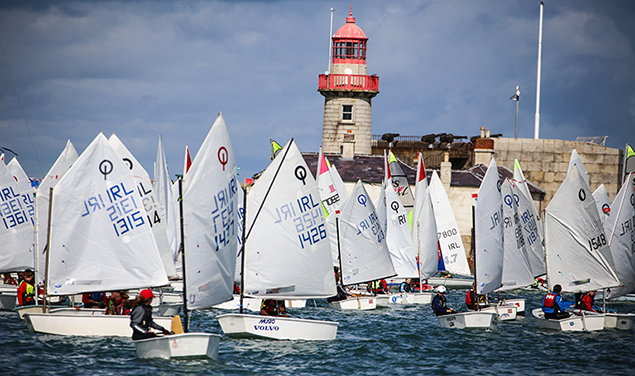 The popular combined DBSC Junior September series. If other junior activities were combined it would provide critical mass for a common ‘class policy’ and to enable streaming of sailors into like-minded groups
The popular combined DBSC Junior September series. If other junior activities were combined it would provide critical mass for a common ‘class policy’ and to enable streaming of sailors into like-minded groups
Create a stronger, more cost effective, open junior sailing model:
The importance of getting sailors involved at an early age is known to all, and is borne out by a recent British Marine Federation survey that found some 40% of sailors started as a child, while 30% were introduced to the sport by family or friends.
Dun Laoghaire has a unique opportunity to pool resources for a dynamic junior and youth sailing training environment. That is, if the clubs can come together with, for example, the INSS and DLRCoCo to form a combined organisation to run the club junior sections, and develop a public or newcomers element – the focus here being on combining the on-the-water elements:
- Run one programme in which everyone participates (no change in location of boats, etc).
- Use common instructors.
- Combine the sailors afloat at the various levels.
- Pool RIBs and equipment.
- Hire professional administration to ensure continuity and maintenance of standards.
The potential benefits of this approach are many. Elimination of duplicated costs, the increased scale would enable the employment of a high-calibre instructor to focus on the fun aspects of getting involved in sailing, as well as a specialist coach to focus on the most talented sailors and stream the best prospects for competition.
Combining the junior sections would provide critical mass for a common ‘class policy’ and to enable streaming of sailors into like-minded groups, which will be more enjoyable for the sailors, and bolster clubs’ membership retention efforts.
A single organisation would be more cost-effective than the existing stand-alone operations, and would also create a structure to enable newcomers to become more integrated into Dun Laoghaire’s sailing community, again resulting in stronger club membership.
The goal is a ‘Dun Laoghaire culture’ among future members, rather than unnecessary club rivalries. At the same time, there should be no loss of individual club identity; there hasn’t been a problem combining for DBSC racing, after all.
A united waterfront would put Dun Laoghaire in a strong position nationally to attract top young sailors and national training squads.
Such a move would also demonstrate the right ‘joined-up thinking’ to DLRCoCo, and provide a platform to develop schools and community programmes in conjunction with them.
In late August, the harbour's first Olympic medal brought the yacht clubs, the town marina, the local sailing school, the boatyard, the town council and the harbour company together in celebration like never before. Maybe all we need is Annalise Murphy–style determination? Is it possible that her Olympic Silver could be the inspiration to put Dun Laoghaire on a new tack?
Modern communications, and in particular social media's 'electronic word–of–mouth', means no other generation has had the same chance to shape the future like we do. It's up to us how we do it but surely it is better to bake a bigger pie than fight over the remaining crumbs?
A definitive plan for 'Dun Laoghaire Sailing Inc' must be the first step. As all sailors will tell you, it is the set of the sails not the direction of the wind that determines which way you will go.
Let's Make Dun Laoghaire Sailing Great: We are keen to hear from readers on this very pertinent subject. All ideas and proposals welcome. Please let us have your comments below.
Honouring An Olympic Sailing Gold Medal of 68 Years Ago
These days Dermot O’Flynn, Director of Training in the Royal College of Surgeons in Ireland, does much of his sailing in a classic Water Wag dinghy in Dun Laoghaire and Dublin Bay. But he is a man of wide-ranging nautical experiences and interests, and he has a gem of a story to share with us here:
In life you get some opportunities to do the right thing, and for me this was one of them. In January 2014 my father Dermot O’Flynn, past President of the Royal College of Surgeons in Ireland, died suddenly at the wonderful age of 94. A father, a great surgeon, and a yachtsman who enjoyed any opportunity to be out and about near or on the sea, he left me many happy memories. And he also left me an Olympic Gold Sailing Medal from the 1948 London Olympic Games (understandably known as the Austerity Olympics) which was won by Jim Weekes, who had crewed on the winning American 6 Metre Llanoria.
She was designed by Sparkman & Stephens, and owned by Herman Whiton, who was a member of Seawanhaka Yacht Club on Long Island, New York. On the crew registration for the 1948 Olympics, Jim was listed as James Weekes and the rest of the crew from Seawanhaka Yacht Club were Herman Whiton, Alfred Loomis (who was one of the leading sailing journalists of his day), Michael Mooney & James Smith.
 The veteran but beautifully restored Llanoria, European 6 Metre Classic Champion 2016
The veteran but beautifully restored Llanoria, European 6 Metre Classic Champion 2016
The 6 Metres were the largest and most prestigious of the yachts competing in the 1948 London Olympics, which also included Dragons, Swallows, Stars and the 12ft Firefly dinghy. The famous Danish sailor Paul Elvstrom won his first Gold Medal that year sailing a Firefly dinghy, so Jim and the crew were in good company.
My father was gifted the Medal in 1981 by James Weekes’ wife Kay, who had a been a long term patient and friend of my father. In the accompanying letter she wrote:
“This token comes with my deep affection, no other man deserves it better other than the one who won it, there are no sailors in my family, hand it down to one of yours when the time comes”
My father made the decision to hand down the medal to me probably because I survived the Fastnet Race in 1979 in a 30ft racing yacht, sailed across the Atlantic in 35-foot Camper & Nicholson sloop in 1981, managed a second overall in The Middle Sea Race, and loved sailing all types of boats whether they be dinghies, IRC racing machines, or classic cruising yachts. Yet after putting the medal under lock and key for a while, I came to the decision that the medal did not belong to me or my family, but should be returned to Seawanhaka YC, and so my journey started. Very quickly I discovered that there was only one living relative, named Townsend Weekes, who was also – surprise surprise….- a member of Seawanhaka YC, and he was delighted to hear the medal would be coming home.
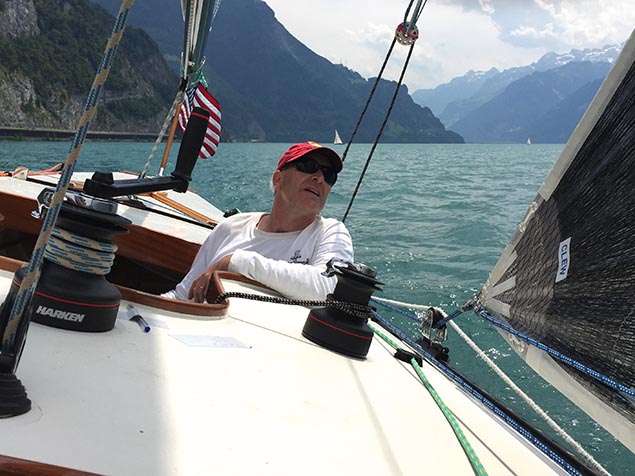 Dermot O’Flynn helming Llanoria on Lake Lucerne, July 2016
Dermot O’Flynn helming Llanoria on Lake Lucerne, July 2016
Townsend informed me that Jim was originally from Oyster Bay, Long Island, New York. He had three siblings, and the family have a long history with Oyster Bay, dating back to 1653 when Francis Weekes settled there. Jim’s grandfather was one of the earliest members of Seawanhaka Yacht Club, and both his brother Arthur and brother in-law Porter were Commodores of this yacht club.
Jimmy - as the family called him - was a terrific athlete who loved sailing and was the best rifle shot of his three brothers. Like his brothers, he had a distinguished career in the American Navy in World War 2, becoming an Executive Officer on a battle cruiser in the Pacific.
Nobody can remember how Jimmy got selected to sail on Llanoria for the Olympics in 1948 but obviously Herman Whiton liked the ‘cut of his jib’, and the Gold Medal sealed the success of their mutual respect.
James Weekes married Kay in 1962, and they moved to Dublin as they wished to live in Ireland, but sadly Jim died suddenly in 1977 at the age of 65. Kay and James had no family, however Kay had family from her first marriage, and they and other Weekes relatives in America had always wondered what happened to the gold medal, so they were intrigued – to say the least - to hear where it had ended up.
Having discovered the background to Jim Weekes, naturally my attention was drawn to the great Llanoria US 83, and what might have happened to her. My journey started by accident when I was delivering an Alden 54 called Tara from St Petersburg to Stockholm via the Finish Archipelago. We happened to spend two wonderful nights on the marina of Helsinki Yacht Club and the club has a half model of Llanoria, plus a photo of her winning the Seawanhaka Cup, for Llanoria had also won the 6 Metre Class in the 1952 Olympics in Helsinki – she is the only yacht to have won two Olympic Gold Medals.
My next port of call was the famous yacht designers Sparkman & Stephens in New York. They very kindly went through their records and found a line drawing of the yacht designed by Olin Stephens which they sent to me, however at that time they had no record of Llanoria’s present location.
But I kept digging for more information, and finally got in touch with Matt Cockburn, secretary of the Puget Sound 6 Metre Association in America’s Pacific Northwest, who gave me the great good news that Llanoria had been totally refurbished by her current owner Peter Hofmann, whose family had purchased her in 1980, and that she had just won the 6 Metre 2015 World Championships (Classic Division) at La Trinite Sur Mer on France’s Biscay coast, helmed by Eric Jespersen.
 Reception at the Seawanhaka Yacht Club on Sunday October 2nd to hand over the James Weekes Memorial Trophy
Reception at the Seawanhaka Yacht Club on Sunday October 2nd to hand over the James Weekes Memorial Trophy
I then contacted Peter Hofmann who was fascinated by the story of the Medal, and he kindly agreed to me joining him and the crew of Llanoria for a sail as they prepared for the 6 Metre European Championships on Lake Lucerne in July 2016. What a joy it was to sail with a crew who knew their yacht so well, and to watch them tune the rig, adjust the sheets, move the mast and create the perfect sail shape for 6 Metre sailing in 8-10 knots of breeze.
Now it was time to move on to the next stage of the Gold Medal’s journey home. In memory of James Weekes I agreed with the Seawanhaka Yacht Club Commodore, Vice Commodore and Committee, through a Deed of Gift, to present the Medal to the Club as ‘The James Weekes Olympic Gold Memorial Trophy’
The trophy represents the coast line of Torbay on England’s south coast, venue of the 1948 Sailing Olympiad, in Irish Silver, with the Gold Medal suspended in the centre of the 1948’s 6 Metre racing area. It is placed on a piece of Irish Bog Oak which is more than 800 years old, chosen for the very personal reason that on the day my father died, his parish priest said to me on hearing the sad news: “Dermot, a great oak has fallen”
At the beginning of October, it gave me and my family great pleasure to present this Memorial Trophy to Seawanhaka Yacht Club, and l look forward over my lifetime to hearing about the sailors who win this trophy, and their successes both on and off the race course.
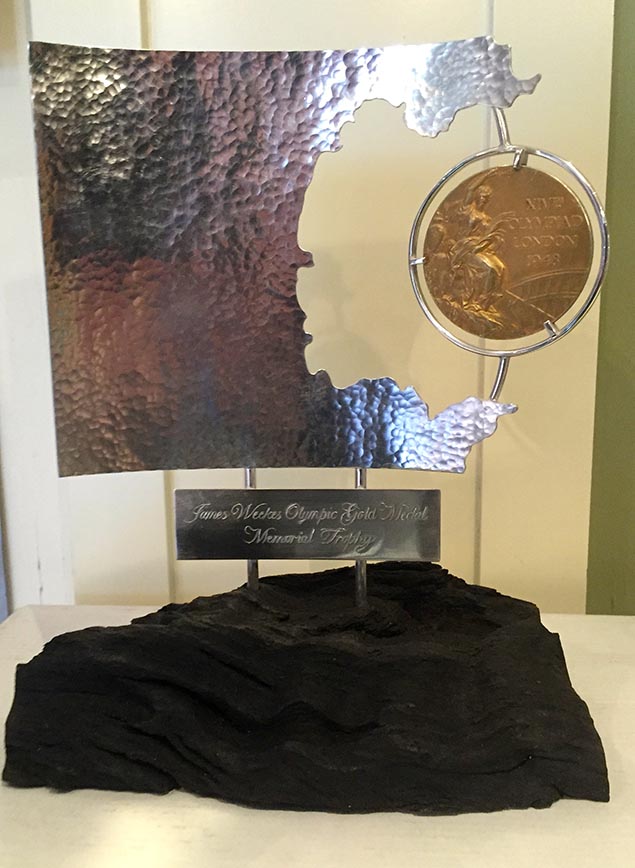 The James Weekes Olympic Gold Medal Memorial Trophy honours many cherished memories 68 years down the line since the Torbay Olympics.
The James Weekes Olympic Gold Medal Memorial Trophy honours many cherished memories 68 years down the line since the Torbay Olympics.
Read Today's Irish Sailing & Boating E–News from Afloat.ie
Read Afloat's e–news below with all the latest sailing and boating highlights including: Winter crib sheets: How to breathe new life into your sails; Westerly's wizard choice for manageability; and why we’re in need of Newfound pride
Sign up for a daily digest of Irish sailing and boating news direct to your email on our home page.
|
Tributes to Kinsale's John Twomey as Paralympic Sailing Ambassador Retires in Rio
John Twomey bowed out of his Paralympic sailing career in Rio at the weekend after a tricky series left the Irish Sonar crew in 13th place overall. Kinsale's Twomey, Ian Costelloe and Austin O'Carroll had hoped to finish on a high especially after seeing training partners finish in the medals.
Twomey retires from Paralympic sailing, marking the end of a career that includes 11 Paralympic Games, a bronze and a gold medal in the discus and finishing in Rio proudly carrying the Irish flag in the opening ceremony.
'Our two training partners took silver and bronze and we are just as fast as they are, we just didn't have the knack of dealing with the winds here,' Twomey told RTE news.
The Rio regatta was a significant day for Ireland in Paralympic sport as it marked the retirement of one of Paralympics great ambassadors and Ireland's longest serving competitor.
'Sonar skipper John John leaves behind an impressive legacy in Paralympic sport that will surely serve to inspire the next generation of Paralympic sailors. Thanks for all the years as a great competitor John and we wish you all the best in your next endeavours, ' an Irish Sailing Association (ISA) post on social media said.
In a finale fitting on the setting, the Rio 2016 Paralympic Sailing Competition came to a spectacular close with the medals decided in front of a sell-out crowd lining the shores of Flamengo Beach.
Racing on the Pao de Acucar (Sugarloaf Mountain) race course, onlookers were treated to a thrilling climax in which some medals were settled by just seconds.
After 11 races under the backdrop of Sugarloaf Mountain and Christ the Redeemer, the stakes were high for a chosen few sailors who had the opportunity to grab a Paralympic medal. But while some would feel the elation, some would inevitable miss out.
With the gold wrapped up in the Sonar by the Australian team of Colin Harrison, Russell Boaden and Jonathan Harris with a race to spare, it was down to the battle for silver and bronze.
Mathematically there were still quite a few teams left in the fight, but USA and Canada, sitting in second and third respectively, had the advantage before the final race got underway. That advantage paid dividends in the end as Alphonsus Doerr, Hugh Freund and Bradley Kendell (USA) confirmed silver with Paul Tingley, Logan Campbell and Scott Lutes (CAN) taking bronze, but only just.
USA set their stall out early and headed for the top end of the fleet, they knew where they needed to be. At the half way point they hit the front, and they stayed there to claim a race win and the silver medal.
Kendall will take to the podium with his teammates, but he had to endure a restless night as he knew the pressure was on, "Not much sleep last night, not much sleep. Woke up in the middle of the night and certainly started thinking about the race and how we were going to get out there and manage it and what we had to do. We wanted to win that race and go out in style and that's what we do. But not much sleep.
Freund bounced in with enthusiasm, "I slept great last night and woke up early and did some yoga.” "Good for you,” said Kendall. The sleep patterns may be different but the collective result was the same.
Claiming the 2016 Para World Sailing Championships earlier in the year had given the Americans the experience to call upon when faced with a similar final race situation, "We went into today knowing we'd had one rough day and four pretty good ones and we were in the same position we were in before the world championship with everything to play for. We knew if we sailed the boat the way the three of us know how to, everything would work out. It was really good execution from every person on the team.”
Race execution paid, but there was also a little help from another source as Kendall called in an old 'family favour', "I'm half a New Zealander, my dad was from there. The Kiwis sort of owed us a favour from the other day. They really fought with us at the end. They weren't giving us too much. We knew we had to go straight to the finish line as fast as we could and we were still working on sail trim on the reach. That's what it was all about.”
New Zealand's Richard Dodson, Andrew May and Chris Sharp rounded the first mark back in eighth position, but from there they charged to the front to worry the Canadians. The Kiwis pushed USA right to the finish but missed out on the bullet by just one second.
Further back the Canadians weren't making life easy for themselves. From the start they fell to the back and had to pick off a few boats and make their way through the field in the hunt for a medal.
USA had beaten New Zealand to first by one second and Canada eventually pipped France by one second to get seventh. That collective two seconds had shaped the medal podium as Canada and New Zealand where now tied on overall points. The Canadians won on a countback thanks to two race wins to the New Zealanders one.
For Campbell, it was all a bit too close for comfort, "We were unsure on the results and it probably took three or four minutes to find out where we finished, but we didn't know until our coach told us. We knew it was tight and when racing was done it was a pressure release.”
Teammate Lutes summed up for the team what the being on the podium means to them, with a traditional culinary reference, "It's a treat, it's a treat,” he chuckled. "We love racing and that's why we do it. No matter what, happy to be here but on a cake, icing is nice and this is the icing on the cake.”
World Sailing Struggles With Presenting Rio Sailing Results
#Rio2016 - World Sailing continues to struggle with presenting the results of the Olympic Regatta.
The normally very efficient system that brings the World Cup results seems to have failed at a crucial moment.
The issue seems to be an inability to calculate the overall totals and sort them into leader order.
Interestingly, the workaround that World Sailing has put in place is to direct browsers to the official Rio results site.
Here, too, there are issues as this site does not show how discards figure in the overall total.
However, Afloat.ie has discerned that the World Sailing system seems to be operational again and can be accessed HERE.
Users are advised to save that link, as clicking on the other hyperlinks on this page may take you to the official Rio 2016 results site.
Protest decisions are also available through the same link. However, World Sailing fails to indicate which fleet the protest applies to, so there is a bit of guesswork involved in working out which event is affected by the protest.
ISA Tries To Get Rid Of Elitism In Sailing
I have been vocal over the past few months in expressing concern about improving access to sailing and combating the impression that the sport is elitist. I spoke about the need for initiatives at the annual conference of the Irish Cruiser Racing Association in Limerick and at the annual meeting of the South Coast Offshore Racing Association in Kinsale. Scroll down to listen to the podcast below.
While both are racing-focussed organisations they were the two which offered an opportunity to raise the subject and credit to them for doing so. Both meetings acknowledged the need for increasing recruitment into the sport and the difficulties experienced in many clubs of holding onto members and crewing cruisers for racing. And issues were raised as to whether clubs and boat owners were sufficiently welcoming to potential newcomers, whether the cost of memberships was too high and whether there was too much emphasis on racing and the ‘fun’ element of the sport had been lost.
There is more to sailing than the competitive aspect and more also than cruiser racing. However, dinghy fleets, while having less of a ‘numbers’ requirement to sail boats, have also been experiencing the need to ensure their future and they share a common desire to increase club memberships and active sailors.
So I am glad to see the response of the Irish Sailing Association in the launching of the TRY SAILING programme. The official launch will be on Monday next, Bank Holiday Monday in Kinsale Yacht Club in Co.Cork at 1p.m. where a number of schools and groups with disabilities from the local area are going to do a ‘try sailing’ session.
Ciaran Murphy, the ISA Regional Development Officer, specialising in Access and Participation, is leading the Try Sailing initiative. He was Manager of Lough Derg Yacht Club before joining the Irish Sailing Association. On this week’s THIS ISLAND NATION PODCAST, I discuss its purpose, where and how it will be implemented and whether it will eradicate that impression of elitism.
There may be some expense involved in training programmes, but at a low cost and there are other opportunities being offered alongside TRY SAILING, such as the CREW POINT which a number of clubs have committed to trying this season to encourage potential newcomers to approach clubs directly on sailing days and evenings.
Combined, these are encouraging new approaches to increasing interest in sailing.
Belfast Lough Celebrates 150 Years of Organised Sailing in Style
The development of organised sailing in Ireland seems to have spread northeastwards from the south and southwest coasts. Although the great chieftain Hugh Maguire had a fleet of pleasure vessels including sailing craft on Lough Erne in County Fermanagh in the 1500s, while the noted scientific polymath Sir William Petty found a sailing “pleasure boatte” on Dublin Bay to test his catamaran Simon & Jude against in 1663, it was on Cork Harbour that we find the first formal organisation with the foundation of the Water Club in 1720 writes W M Nixon.
Before the advent of good roads, and long before the railways arrived, Ireland’s myriad waterways and lakes provided the best options for the inland transport both of goods and people, and inevitably some gentrifried working boats were also used for relaxation, and the next club to be formed was Lough Ree YC in 1770. By 1820, the world’s first club specifically organised to provide racing came into being on Lough Erne, then nearby on Lough Gill in Sligo, the Ladies’ Cup was first raced for in 1822, and it still is cometed for today, though now at Sligo YC’s sea base at Rosses Point.
In the pre-famine era before 1845, the relative affluence of the west and southwest of Ireland supported the landed classes in yacht ownership, and a regatta at Kilrush in the Shannon Estuary in 1828 saw the establishment of the Royal Western of Ireland YC, which at its height in 1838 had a fine fleet of 18 cutters – some of quite substantial size - based in Kilrush Creek and spreading outwards to families along the coast such as the O’Connells of Tralee, Cahirsiveen and Derrynane.

The Game Changer. Dun Laoghaire’s first regatta in 1828 set Dublin Bay on course to be the pace-setter in yachting development.
But 1828 also saw the first regatta to be staged at the new harbour of Kingstown on Dublin Bay, and the success of this provided an unrivalled focus for the development of new ideas in sailing not only in Ireland, but at an international level. Whereas other sailing area saw the locations of activity spread across several centres large and small, in Dublin Bay there was just this one big powerhouse of sailing development through which all the recreational nautical energy of the capital city was channeled. The Royal Irish YC came into being in 1831, the Royal St George YC got going in 1838, and soon Kingstown outstripped most comparable centres at home and abroad, particularly in racing development.
Yet at this time Belfast was already the fastest-expanding city in Ireland, and it was moreover a growing centre of genuine wealth-creating manufacturing industries and ship-building enterprises. Why wasn’t Belfast Lough in the forefront of sailing development by the 1850s?
It wasn’t as though there wasn’t a small but time-honoured local recreational sailing tradition on Belfast Lough. During the 1780s and 1790s, Belfast had been a place of liberal ideas and social innovation, and a small group of recreational sailors led by Henry Joy McCracken pioneered cruising from Belfast Lough to the west coast of Scotland and the Hebrides. But then in 1798 McCracken also led the rising of the United Irishmen, and when it was suppressed he was executed by hanging in the Cornmarket in Belfast on land which his grandfather had donated to the town.
Subsequently, the Presbyterian majority in the north turned in on themselves and concentrated on commerce and manufacture and literally minding their own business. But though, as prosperity returned, a small group of McCracken’s former shipmates formed the Northern Yacht Club in Belfast Lough in 1824, Belfast’s rapid industrial expansion made the port very limited as a yacht harbour, thereby limiting their growth.
Belfast Lough may have provided splendid sailing water, but it was very poorly served by other smaller harbours, so the Northern Yacht Club members often found themselves sailing to the more congenial and well-serviced shores of the Firth of Clyde. They soon formed a Scottish branch, and by 1838 the Royal Northern Yacht Club - as it was to become, with an impressive clubhouse in Rothesay - had taken over the few remaining assets of the Belfast Lough branch, and that was the end of any club in the Lough for another quarter century.
Yet any student of sailing history will know that in 1856, Lord Dufferin from Clandeboye near Bangor on the shores of Belfast Lough made a celebrated voyage to the high Arctic with his schooner Foam. And in 1865, one of the most successful racing schooners of all time, the 99ft Egeria, was built for leading Belfast linen manufacturing magnate John Mulholland. So why wasn’t Belfast Lough sharing the sailing fame of other Irish centres such as Dublin Bay and Cork Harbour, which had shown their pre-eminence by staging the world’s first recognisably modern offshore race from Dublin Bay to Cork Harbour in 1860?
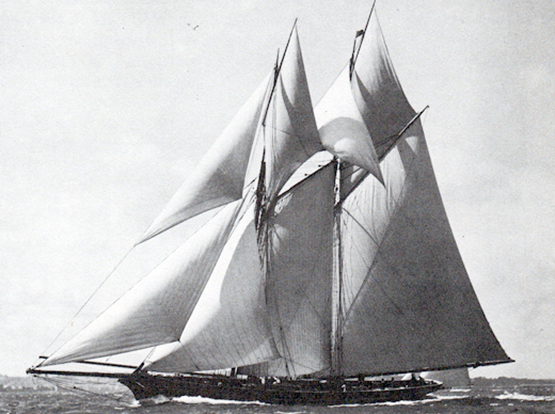
The extremely successful racing schooner Egeria was built for Belfast business magnate John Mulholland in 1865, but she was seldom if ever in Belfast Lough
The simple answer seems to be that in its period of hyper-growth, the business of Belfast was business, and sailing for recreation was not a Belfast business. Those who expected to sail at the highest level did so elsewhere, and once the Belfast to Dublin railway had been connected in 1855, it was as handy for the more affluent would-be yachtsmen to avail of the proper facilities in Dublin Bay rather than risk their yachts on exposed moorings in Belfast Lough, where shore facilities were still woefully lacking.
But in time the rapid rise of an energetic middle class in Belfast saw increasing demand for sailing amenities and events nearer home. We know that a regatta of some sort was staged at Holywood immediately east of Belfast on the lough’s south shore in 1854, and it was at Holywood – despite the little town’s drying anchorage – that the first club since the Northern YC in 1824, the Hoywood Yacht Club – was formed in 1862, and it still exists, Belfast Lough’s senior club.
Then in 1866 a regatta was staged from the only half decent harbour on the lough, at Carrickfergus, and the organisers were pleasantly surprised by the number of boats which turned out, boats whose owners had squirrelled out bits of shelter for their craft in small places like Donaghadee, Groomsport, the tiny drying harbour at Bangor, in the open roadstead off Cultra, in the cleaner parts of Belfast docks, in Carrickfergus itself, and round the corner in Larne Lough.
From this there immediately emerged the Carrickfergus Amateur Rowing & Sailing Club, but mostly to cater for local demand. But soon afterwards in Belfast the Ulster Yacht Club was formed by a group of affluent businessmen, professionals, industrialists and landowners with Lord Dufferin as their Commodore. By 1869 he’d seen to it that they’d become the Royal Ulster Yacht Club, but it was an organisation which was resolutely to function without a clubhouse until 1899, nevertheless growing in prestige with every passing year.
Thanks to that focus of interest through the Carrickfergus Regatta of 1866, 2016 will see double celebrations on Belfast Lough with the 150th Anniversaries of both Carrickfergus Amateur Rowing and Sailing Club (which everyone knows as Carrick Sailing Club), and the Royal Ulster Yacht Club, which since April 1899 has been based in an impressive Arts & Crafts clubhouse on an eminence above Bangor’s waterfront.

The RUYC clubhouse was built in 18 months and opened in 1899 in order to be ready for Thomas Lipton’s first America’s Cup campaign
When the clubhouse was built, the harbour at Bangor was still rudimentary, but the sailing was great. However, since 1984 Bangor Bay has been turned into one of Ireland’s largest marinas, and now RUYC has the berthing facilities and the sailing water to stage major events with confidence.

Befast Lough provides excellent sailing water, but until the marina were built at Carrickfergus and Bangor, it lacked sheltered berthing

Carrickfergus Marina, with the harbour and its famous 12th Century castle beyond
Equally at Carrickfergus they also have a marina – in fact it pre-dates the one at Bangor – but as Carrickfergus was also the base of the extraordinarily productive yachtbuilder John Hilditch, albeit only from 1889 to 1913, one of the main parts of their celebration is going to be a Hilditch Regatta, not just for boats built by him such as Hal Sisk’s famous 1894 Watson cutter Peggy Bawn, the Howth 17s of 1898, and the RNIYC Fairy Class of 1901, but indeed for any classic or traditional craft, as Carrick has always been a spiritual home for the Old Gaffers Association.

Bangor Marina, with Ballyholme Bay beyond
Royal Ulster has meanwhile taken a different track through sailing history, for between 1899 and 1931, it was the club through which Thomas Lipton made his five America’s Cup Challenges, which has tended to obscure the fact that in the 1880s and 1890s, Belfast Lough with RUYC in a key role were setting a fantastic pace in sailing development, as they were trying to get a one design keelboat class going as long ago as 1889, and by 1895 they’d brought the Belfast Lough One Design Association into being with a determined young sailing man called James Craig as Honorary Secretary. Membership of the BLODA was open to any member of one of the recognised six clubs now based round the lough, but young Craig – who later went on to become Lord Craigavon, first Prime Minister of Northern Ireland in 1921 – was realistic in his expectations for the life of a strict one design keelboat class, and he only expected his members to be “in class” for three seasons.
By 1896 they’d the first two boats of a new 15ft LWL keelboat class designed by William Fife, no less, sailing on Belfast Lough, and before the summer was out the signs were good for a significant increase in numbers for 1897. James Craig was insisting the boats be built by John Hilditch, as he was noted for sticking strictly to the plans as drawn by the designer, whereas the builder of the first two boats for 1896, Paddy McKeown in the heart of Belfast, was always trying to improve on the designs, even if they were from Fife.

Regatta day for the Dublin Bay 25s – their design was inspired by the Befast Lough Class I boats.
But events overtook the programme. A group of affluent Belfast Lough movers and shakers decided they certainly wanted a One-Design class to the Belfast Lough ODA rules and designed by William Fife, but they wanted a proper sea-going boats with a cabin, around 37ft in hull overall length, and 25ft on the waterline, and setting a proper gaff rig with a jackard topsail rather than the modest little gunter rig set by the 15ft LWL boats, which were still referred to as Class I.
But as the idea for the bigger boats gained traction, they became Class I, and for a while the 15ft LWL boats became Class II, but after 1900 they were Class III when a 20ft LWL class came along. But meanwhile in late 1896 and early 1897, the Hilditch yard went mad, building nine of the new 25ft LWL boats. Even Lord Dufferin and his friends Lord de Ros and Lord Bangor came round from County Down in April 1897 to the tough town of Carrickfergus to see this remarkable new class of boats being built. And once the 25 footer had their first race off Carrickfergus on May 29th , they swung into action with what today would be called a series of promotional tours, as they did all of Clyde Fortnight after a stormy crossing of the North Channel, and then after being back in Belfast Lough for long enough to race the RUYC regatta, they headed south to Dublin Bay in late July and inspired the creation of the Dublin Bay 25 class.
1898 was when they were in their prime, and by 1899 some owners were aready invoking the “three season” rule to move on, but in fact the class continued to race actively – though sometimes with very depleted numbers – on Belfast Lough until the end of the 1909 season.

John Hilditch was very busy in 1897 – in addition to the Belfast Lough Class I boats, his yard also built this 56ft motoryacht Romance for A J Lepper, for whom he’d built Peggy Bawn in 1894.
We get some idea of the boat-building pace around Carrickfergus in the late 1890s when we realise that in 1897 John Hilditch and his men were also building a 57ft Dixon Kemp motor-yacht, the Romance, for A J Lepper, for whom they’d built Peggy Bawn so well in 1894, and no sooner was the Romance out of the way than they turned to the next job, the building of the first five Howth 17s which their owners were able to sail the 90 miles to their home port in April 1898.
So obviously there’s going to be quite a complicated programme around Belfast Lough in late June and early July this year. And as the Howth 17s are in the unique position of being a Hilditch class which is not Belfast Lough-based, they hope to be able to pay their respects at Carickfergus both to the memory of their builder and to the 150th Anniversary of the Carrickfergus club, while also being able to do full justice to the Classic One Designs Regatta, which RUYC will be staging from Friday June 24th to Sunday June 26th.
The Hilditch Regatta meanwhile is from the evening of Wednesday June 22nd to Saturday June 23rd, when the fleet heads from Carrickferus to Bangor for a sail-past as part of the Royal Ulster events, but with some of the Old Gaffers then returning to Carrick (after due celebrations in Bangor) as the Carrick event is seen partially as a follow-on to the Portaferry Sails & Sounds the previous weekend, which is very much an Old Gaffers event.
In Carrickfergus are (left to right) Nick Massey, Roddy Cooper, Tom Houlihan, CSC Commodore Wendy Moore, and Ian Malcolm. Photo: W M Nixon
But for classes like the Howth 17s, despite their antiquity proper racing is what it’s all about, so I tagged along with a reconnaissance group of Howth 17 eminences when they went up North to suss out the scene this week. And as the group included Nick Massey who re-energised the class when it was going through a flakey period in 1972, Ian Malcolm who is playing a key role in the class’s current revival such that they’ll have eighteen boats racing this year, Roddy Cooper who owns the Hilditch-built Leila, and Class Captain Dr Tom Houlihan, you can be quite sure there wasn’t a dull moment.
First call was with Wendy Moore at Carrickfergus, where she’s Commodore for the 150th as the club settle into the new clubhouse after a disastrous fire three years ago, and as she’s also the Marina/Boatyard Manager and the newest addition to the ranks of owners in the local thriving Ruffian 23 class, everyone was on the same wavelength.

You’ll always find it’s now in a carpark….Roddy Cooper and Ian Malcolm stand on the spot where their Howth 17s Leila and Aura were built in 1898, with Carrickfergus Castle in the background. Photo: W M Nixon
Then we swung by Royal North of Ireland Yacht Club at Cultra on the south shore of the lough, home to the Hilditch-built Fairy class against whom the Howth crowd regularly have inter-club races, and fortuitously met up with Northern Ireland Old Gaffers Association Chairman Gary Lyons for some very high-powered info exchange. As a result we round out this week’s blog with a photo which does justice to the Portaferry Sails & Sounds which he is organising in June.
Then on in haste for a sailing business lunch (delicious) at Royal Ulster YC with Vice Commodore Myles Lindsay, Rear Commodore Greg Taylor, Honorary Sailing Secretary Robin McKelvey and Press Officer Fiona Hicks, learning yet again that the RUYC clubhouse is such a store of sailing memorabilia that it’s a difffcult to concentrate on the formal agenda, but I think the Howth men and the Bangor men understood each other very well indeed.

Myles Lindsay, Vice Commodore RUYC

Robin McKelvey, Honorary Sailing Secretary RUYC
The RUYC people have a lot on their plate, for no sooner is the Classics Regatta out of the way than they gear up at the beginning of July for an assembly in Bangor of cruising boats from the ICC, the RCC, the OCC, the CCC and other associated organisations, followed by a 150th Anniversary Cruise-in-Company along the Antrim coast and on to the West Coast of Scotland and the Hebrides.
But for the recce group from Howth, now it was down to Bangor Marina where manager Kevin Baird couldn’t have been more obliging, but the Howth 17 men all fell in love with the classic ketch Morna berthed right next to the marina office, so Fiona and I had to speed them on their way to the exhibition of 150 Years of sailing in Bangor Museum.
The classic ketch Morna in Bangor Marina. Photo: W M Nixon
And then after that, duty done and work completed, I took them for the treat of the day, down among the hidden places of Strangford Lough to meet up with Kenny Smyth at his boatyard, which for any one who is into classic, vintage or traditional boats is heaven on earth. And of course it emerged that Kenny the King of the River Class, Whiterock’s historic Mylne-designed premier fleet, has recently become Commodore of Strangford Lough Yacht Club. So we headed for home into a gorgeous sunset having notched up two Commodores, one Vice Commodore, one Rear Commodore, one Chairman, one Honorary Sailing Secretary, two Marina Managers and one Press Officer. And if that’s not a good day’s work on the diplomacy and negotiating front, then I don’t know what is.
The eternal enthusiast. Kenny Smyth of Whiterock runs a boatyard, he is also Commodore of Strangford Lough Yacht Club, he is River Class champion, and he just loves talking about boats night and day. Photo: W M Nixon
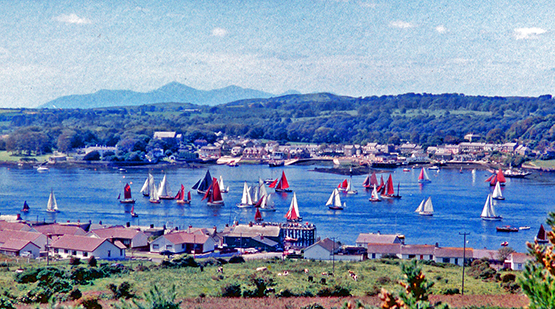
The promise of summer – the classic and traditional season in the north starts with Portaferry Sails and Sounds on June 16th.



























